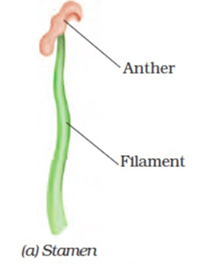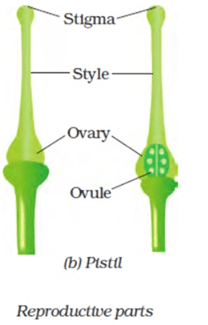NCERT Solutions Class 7 Science Chapter 8 Reproduction in Plants is provided here to help students in understanding the topic thoroughly. All these solutions are solved by experts with a detailed explanation. Class 7 NCERT Solutions for Science Chapter 8 includes all the textbook exercise questions and answers. These solutions will help students complete their assignments & homework.
Class 7 Science Reproduction in Plants Questions and Answers
Exercise Questions
Question 1: Fill in the blanks:
(a) Production of new individuals from the vegetative part of parent is called ___________.
(b) A flower may have either male or female reproductive parts. Such a flower is called _______.
(c) The transfer of pollen grains from the anther to the stigma of the same or of
another flower of the same kind is known as __________.
(d) The fusion of male and female gametes is termed as ____________ .
(e) Seed dispersal takes place by means of ________ and __________.
Answer:
(a) vegetative reproduction
(b) unisexual flower
(c) pollination
(d) fertilization
(e) wind, water
Question 2: Describe the different methods of asexual reproduction. Give examples.
Answer: Different methods of asexual production are:
(i) Vegetative propagation: It is the ability of a plant to produce new plants from roots, stems, leaves, and buds.
(ii) Budding: In this process, a new individual from a bulb-like projection, bud, grows and gets detached from the parent to form a new individual and it is mostly observed in yeast.
(iii) Fragmentation: It is a form of asexual reproduction where a new organism is formed from the fragments of the parent body. It is the only mode of asexual reproduction in Spirogyra.
(iv) Spore formation: Many non-flowering plants reproduce through spore formation. The spores are tiny spherical unicellular structures protected by a thick wall. The spores are stored in a hard outer covering and this is called a sporangium. Under favourable conditions, the hardcover breaks and spores spread for germination.
Question 3: Explain what you understand by sexual reproduction.
Answer: Sexual reproduction means involvement of two parents in the process of reproduction. It is found mainly in higher plants where male gamete and female gamete fuse to form a zygote. These zygotes develop into individuals which are not identical. Offsprings inherit the characteristics of both the parents. In sexual reproduction, both parents survive after the process of reproduction.
Question 4: State the main difference between asexual and sexual reproduction.
Answer: Difference between asexual and sexual reproduction:
| Sexual reproduction | Asexual reproduction |
| In this process, two parents are involved. | In this process, a single parent is involved. |
| In sexual reproduction, newly developed plants are not identical to parents. | In asexual reproduction, newly developed plants are identical to the parent and to each other |
| Sexual reproduction involves the fusion of male and female gametes. | In asexual reproduction, plants can give rise to new plants without seeds. |
| Examples are flowering plants, such as Hibiscus, corn, papaya, etc. | Examples are yeast, rose, jasmine, potato, etc. |
Question 5: Sketch the reproductive parts of a flower.
Answer:


Question 6: Explain the difference between self-pollination and cross-pollination.
Answer:
| Self-pollination | Cross-pollination |
| In self-pollination, pollen grains are transferred from the anther to the stigma of the same flower. | In cross-pollination, pollen grains are transferred from the anther of one flower to the stigma of another flower of the same kind. |
| It occurs only in bisexual flowers. | It occurs in both unisexual and bisexual flowers. |
Question 7: How does the process of fertilisation take place in flowers?
Answer: When pollen lands on stigma, it germinates and gives rise to a pollen tube that passes through the style and reaches the ovary of a pistil. When the pollen tube reaches an ovule, it releases the male gametes. A male gamete fuses with a female gamete in the ovule. This process is known as fertilisation. The cell which is formed after the fusion of a male and a female gamete is known as zygote. This zygote divides several times in order to form the embryo present inside the seed.
Question 8: Describe the various ways by which seeds are dispersed.
Answer: Seed dispersal is aided by the wind, water and animals. Sees also dispersed when fruits burst with sudden jerks.
By wind: Seeds and fruits of plants are carried away by the wind, water and animals. Winged seeds such as those of drumstick and maple, light seeds of grasses or hairy seeds of aak (Madar) and hairy fruit of the sunflower, get blown off with the wind to faraway places.
By water: Seeds of aquatic plants or plants near water bodies usually develop floating ability in the form of a spongy or fibrous outer coat as in coconut and get dispersed by water.
By animals: Spiny seeds with hooks which get attached to the bodies of animals and are carried to distant places.
Dispersion of seeds by bursting of fruits: Some seeds are dispersed when the fruits burst with sudden jerks. The seeds are scattered far from the parent plant. This happens in the case of castor and balsam.
Question 9: Match items in Column I with those in Column II:
| Column I | Column II |
| (a) Bud | (i) Maple |
| (b) Eyes | (ii) Spirogyra |
| (c) Fragmentation | (iii) Yeast |
| (d) Wings | (iv) Bread mould |
| (e) Spores | (v) Potato |
| (vi) Rose |
Answer:
| Column I | Column II |
| (a) Bud | (iii) Yeast |
| (b) Eyes | (v) Potato |
| (c) Fragmentation | (ii) Spirogyra |
| (d) Wings | (i) Maple |
| (e) Spores | (iv) Bread mould |
Question 10: Tick (√) the correct answer:
(a) The reproductive part of a plant is the
(i) leaf
(ii) stem
(iii) root
(iv) flower
Answer: (iv) flower
(b) The process of fusion of the male and the female gametes is called
(i) fertilisation
(ii) pollination
(iii) reproduction
(iv) seed formation
Answer: (i) fertilisation
(c) Mature ovary forms the
(i) seed
(ii) stamen
(iii) pistil
(iv) fruit
Answer: (iv) fruit
(d) A spore producing organism is
(i) rose
(ii) bread mould
(iii) potato
(iv) ginger
Answer: (ii) bread mould
(e) Bryophyllum can reproduce by its
(i) stem
(ii) leaves
(iii) roots
(iv) flower
Answer: (ii) leaves
Having a good grasp over CBSE NCERT Solutions for Class 7 Science will further help the students in their preparation for board exams and other competitive exams. NCERT Solutions for Class 7 Science Chapter 8 Reproduction in Plants provided by CBSE Path help students to clear their doubts and to obtain good marks in the exams. All the solutions provided in this article are strictly based on the CBSE syllabus and curriculum.